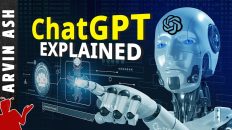To learn about AI Neural Networks in depth, go to: https://brilliant.org/arvinash — you can sign up for free! And the first 200 people will get 20% off their annual membership.
Videos referenced:
Penrose Orch-Or theory of consciousness: https://www.youtube.com/watch?v=bqk1o…
Quantum computing: https://www.youtube.com/watch?v=RCj_B…
Chapters:
0:00 – AI in science fiction
1:09 – AI challenges
2:42 – Turing test
3:46 – computer consciousness
4:17 – Machine learning
6:00 – Theory of mind
7:39 – Can AI be creative? Alphago
10:19 – Can AI be self aware?
12:35 – Global Workspace Theory & Integrated information theory
13:34 – Can we become AI?
14:18 – Quantum consciousness
15:04 – Post biological
16:49 – Learn about neural networks
Summary:
It’s relatively easy to make an AI that can beat a human at chess, because that’s a well defined task. The machine can figure out the best next move by crunching through all the possible moves and counter moves. This is a task beyond the human mind, but not difficult for a fast computer. But translating languages or understanding text is a tougher challenge, because you often need knowledge about context.
Alan Turing, a pioneer of computer science and early AI, suggested in 1950 that an ability to hold a convincing conversation could be a litmus test for whether machines can truly think. This is known as the Turing Test. But most scientists working in AI today don’t think it’s a useful measure of anything about machine minds.
Turing suggested that it would be better to create AI the way we teach children. And that is about how machine learning works. In machine learning, a set of training data is fed into the artificial neural network, and the connections between the nodes of the network are adjusted until they produce the output we’re looking for. What machine-learning AI lacks is common sense. But it’s very hard to pin down what common sense actually is.
When we make decisions in a social context, we assume other people have minds similar to ours, but distinct. This is called “Theory of mind.” Some animals use a theory of mind for deception: for example by hiding food.
Machine learning programs are now used to compose music and write poetry – and people find it hard to tell the difference between. But these are one-trick machines. All the machine is doing is finding patterns in the training data. It isn’t expressing any sentiment.
Still, these AI could be showing creativity, coming up with outputs that surprise humans. That’s what happened with the Go-playing AI, AlphaGo that beat Korean world champion Lee Sedol in 2016. Some of its moves were totally new and unexpected.
Will an AI when ever become conscious or self-aware? Nobody knows for sure since oo one has ever made an AI that is conscious.
But what about in the future? Most scientists are convinced that, whatever consciousness is, it arises out of the laws of physics and chemistry that govern how our neurons work. It doesn’t require any mystical special sauce. There is no reason it should remain forever absent in massive computer simulations that capture all the relevant physics and chemistry of brains.
#artificialintelligence
#consciousness
But others say consciousness just doesn’t work that way. All we’d get is a simulation that only gives the appearance of awareness.
The real problem is that we don’t know what consciousness is, and so we have no idea if it’s the kind of thing that can be wired into silicon circuits. Some researchers think it arises from the way information processing in our brains is structured. According to a view called the global workspace theory, consciousness appears when information from various brain modules. This is an architecture we could build from computer circuits.
Another view, called integrated information theory, is that consciousness is only possible if the elements handling the information are wired together in a pattern quite different from that of today’s silicon chips: one that lets information that the brain is processing be densely looped back on itself.
There are other neuroscientists and philosophers of mind who think that there’s something about biological wetware of cells =that makes it able to host consciousness, which silicon circuits don’t share.
But there’s a third possibility: Maybe we won’t be replaced by conscious machines, but will become them.
Will quantum computers give us some new ways to link electronic components that better simulates the human brain? There is no reason to think so. There is no direct link that we know of between quantum physics and consciousness.
The philosopher Susan Schneider thinks that the most advanced, “superintelligent” alien civilizations will be not biological but “post-biological”: descended from biological organisms but now either blended, like a cyborg with AI, or fully machine-like. They’ll inherit the same evolutionary impulses, like survival, reproduction, competition and cooperation.







